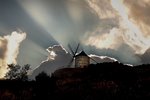Milos Forman, cinematic historian
His first film in eight years centers artist Goya within a bigger
political framework, the Spanish Inquisition.
By Paul Cullum, Special to The L.A. Times July 15, 2007
The official portraitist of "Amadeus" and "The People vs. Larry
Flynt" will return to theaters Friday with "Goya's Ghosts," a costume
drama and controlled historical epic that marks his first film since
the Andy Kaufman biopic "Man on the Moon" in 1999. Yet rather than a
meta-portrait of the great court painter of Spanish royalty Francisco
Goya, "Goya's Ghosts" chronicles the long tail of the Spanish
Inquisition, the "liberation" of Spain at the hands of Napoleon and
the subsequent expulsion of the imported French Revolution by a
guerrilla uprising, in conjunction with the British Duke of
Wellington and the Catholic clergy.
The story is told through the eyes of the premier artist of the era,
or what art critic Robert Hughes, in his definitive biography "Goya,"
called "the first modern visual reporter on warfare." And as
structured by screenwriter Jean-Claude Carriere, who collaborated
with Luis Buñuel, Louis Malle and Volker Schlöndorff, among others,
these rather dry historical events create a startling allegory for
modern geopolitical adventurism
AS "Goya's Ghosts" opens, clerics can be seen furtively studying
Goya's "Disasters of War" series of surreptitious etchings, published
only after the artist's death, and volubly lamenting, "This is how
the world sees us." Inquisitor Javier Bardem rejects Voltaire, and
with him all of Enlightenment thought, as "the dark prince of the
darkest principles" and labels talk of "atoms" and modern science
diabolical. Natalie Portman's character is "put to the question," the
church's palliative euphemism for interrogation and torture, and
imprisoned for 15 years because of a gross misunderstanding. And the
proto-American Randy Quaid, as Spain's King Carlos IV, takes to
hunting vultures (which are drawn to him by the carcass of a dead
sheep, no less). It doesn't take a great leap of imagination to find
Abu Ghraib, global warming, the detaining of terror suspects at
Guantanamo and elsewhere, in not too veiled subtext.
FORMAN says the idea for exploring the life of Goya on film
crystallized for him in 1984, when he and producer Saul Zaentz were
on a promotional tour for "Amadeus" and found themselves in Madrid,
across the street from the Prado.
Spain's national museum is home to the largest collection of works by
Goya as well as Hieronymus Bosch's "The Garden of Earthly Delights,"
a virtual catalogue of the varieties of medieval torture (and briefly
featured in the film). It also, at that time, held Picasso's
"Guernica," probably the premier antiwar artifact of the 20th
century. ("Guernica" was relocated to the nearby Queen Sofia Museum
in 1992.)
"It seems impossible that the painter who paints these gorgeous,
brilliant, official portraits of royals and dukes and nobility can be
the same painter of the black paintings on the other wall," says
Forman. "One is the peak of 18th century style, and one is the
beginning of 20th century style. With 'Disasters of War,' Goya was
probably the most courageous coward, because he didn't do anything
that would put his work in jeopardy — it was published many years
after his death.
"He painted the Spanish royal family, Napoleon's brother [King]
Joseph, the Inquisitors; Goya painted anybody. We know nothing from
him about his political ideas. And I admire his attitude that he just
didn't want to get involved in politics — he wanted to be on good
terms with everybody. If he had stood up against the Inquisition, we
wouldn't have his paintings. They would have been destroyed."
"Napoleon went to Spain in the service of the French Revolution, to
plant the seeds of democracy. And the first thing he did was clamp
down on the church, confiscated their property and banished the
Inquisition. He deposed royalty, because they were squeezing the
population hard with taxes. Wonderful deeds, don't you think? But he
forgot one thing: Over one-fourth of the Spanish population lived on
charity, which was administered by the church. Suddenly, a fourth of
the population was starving, so they went into the streets and
started to loot. Then the killing starts, chaos starts, and here we
are. It's the same situation. I am fascinated by American politics.
When you follow American politics, you suddenly realize that anything
anybody says about America is true — the worst and the best."
He recalls a moment in the '50s when the Czech Communists relaxed
their ban on Western decadence to show a handful of American films
that presented capitalism in a critical light — most notably Sidney
Lumet's 1957 courtroom drama "12 Angry Men."
"So they screened these films, and they couldn't believe the
reactions," recalls Forman 50 years later. "We were not idealists. We
didn't think America was full of angels, that it was a paradigm. But
look at the freedom they had to talk about it! They could show it to
themselves and to the world that they knew about their injustices,
and they were trying to warn people about them. Something was
happening there. And suddenly America became the idol of freedom, a
country with hope. Nowhere is paradise, but we must have hope that we
can build it one day. Once you take away the hope, that's it."
Sunday, July 15, 2007
Subscribe to:
Comments (Atom)

